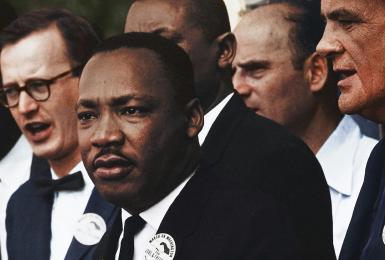There's no "one-size-fits-all" approach to being a great leader. Everyone has different strengths and skills to bring to the table, and no two leadership styles are exactly alike.
If you aspire to be a more effective and inspiring leader, however, you should be aware of some more studied and celebrated leadership theories out there. One you won't want to overlook is the behavioral approach to leadership, which has been embraced by more and more leaders over the past several decades.
So, what exactly is behavioral leadership theory, where did it come from, and what are its potential benefits and drawbacks? Likewise, how can you use behavioral theory in leadership to advance your skills? With a better understanding of this and other leadership theories, you can discover what makes you a great leader and build upon it.
What Is Behavioral Leadership Theory?
Behavioral leadership theory (also commonly referred to as trait theory) is centered around the belief that leadership is a learned behavior—and that by studying the traits of both effective and ineffective leaders, just about anybody can be trained to lead.
This leadership theory contrasts significantly with the so-called "great man theory," which posits that great leaders are born and cannot be made.
The concepts behind the behavioral leadership style can be applied to nearly any field or leadership position, ranging from coordinators and managers to CEOs and other executives. Proponents of this theory believe that leaders can be made by learning effective traits and practicing self-awareness.
The Origins of the Behavioral Theory of Leadership
The origins of behavioral leadership theory date back several decades, when researchers at the Ohio State University began conducting research as part of the Ohio State Leadership Studies in the 1950s. At this time, researchers Hemphill and Coons created what is now known as the Leader Behavior Descriptions Questionnaire. The questionnaire asked members of a leader's team to rate the frequency with which their leader engages in particular behavior on a scale from "never" to "always."
The findings of this initial study revealed that leaders who were supportive of their employees and communicated well were the most impactful. Likewise, those who were more focused on accomplishing tasks through planning, coordinating, and meeting certain standards tended to achieve more effective leadership.
Meanwhile, at the University of Michigan, researchers were conducting similar studies in the late 1950s. Their research aimed to identify two primary behavioral dimensions: job-centered and employee-member-centered behaviors. As part of the Michigan Leadership Studies, researchers focused on leaders' efforts specifically as they related to planning and coordinating work-related actions and resources as well as building strong interpersonal relationships with employees.
Today, both the Ohio State Leadership Studies and the Michigan Leadership Studies are regarded as the standard for behavioral theory in leadership.
Strengths and Weaknesses of Behavioral Leadership Theory
With a better understanding of what behavioral leadership theory entails and its unique origins, it can also be helpful to consider some of the inherent pros and cons behind this approach. After all, no leadership theory is perfect.
Strength: Anyone Can Be Trained
Perhaps the single biggest draw of behavioral leadership theory is the idea that anyone can be an effective leader if they are simply taught how to demonstrate the most essential traits for success.
This idea is understandably appealing to numerous individuals and organizations alike because it refutes the theory that great leaders are born and cannot be made—asserting that with the right training, anyone can learn how to be an effective leader and help a company reach its organizational goals.
This would also mean companies don't necessarily have to undergo extensive and costly recruiting and hiring processes to land great leadership. Instead, drawing from the principles behind behavioral leadership theory, they may be able to recruit from within and train individuals to become great leaders. At the same time, those aspiring to work in leadership roles may feel more confident and capable when they know they're able to adapt and build upon essential leadership skills.
Strength: Gender Neutrality
Another notable strength of behavioral leadership theory is its inherent gender neutrality. That’s because theory asserts that anybody can be an effective leader with the right training and by learning the right leadership skills. Such a notion contrasts with existing schools of thought surrounding leadership—particularly the great man theory that involved the study of historically strong leaders and the idea that they were simply born to lead.
One of many problems with the great man theory is that at the time of its development, almost all the so-called great leaders of the time were military and political leaders. Unsurprisingly, these positions were overwhelmingly occupied by males.
With behavioral leadership theory, on the other hand, a more modern approach allows researchers to study both male and female leaders. A behavioral approach to leadership, in turn, celebrates the idea that any individual (regardless of gender) can adopt the most important traits needed to become a great leader. This, in turn, opens the doors of opportunity for a more diverse leadership pool.
Weakness: Time-Consuming Process
Despite its potential strengths, the behavioral theory in leadership is not without some possible weaknesses. For example, one of the biggest criticisms of this theory of leadership is that training someone to be an effective leader can be a cumbersome, time-consuming process. Realistically, the amount of time and resources needed to adopt the traits necessary to be an excellent leader are simply not available to all individuals and organizations.
However, those who voice this criticism tend to be more supportive of the great man theory and its assertion that the best leaders are born, not made. By this logic, the best leaders don't require extensive time, money, or resources for special training because they already have what it takes to be great leaders.
Some opponents of behavioral leadership theory might also argue that merely "learning" about the most effective traits of great leaders isn't enough to adopt those traits. For instance, an aspiring leader may be taught about the importance of caring about their employees, but this alone is not enough for a person to truly take on that level of empathy. Consequently, this could result in wasted time and resources that an organization cannot recoup.
Weakness: Potential for Biased Judgment
Another potential drawback of behavioral leadership theory to consider is that it may be inherently biased. Unfortunately, many of the theories supporting its approach are derived from Western culture and do not incorporate or consider other cultural contexts.
Considering the fact that further research on behavioral leadership has found that leaders tend to adopt styles that mesh with their own culture, it's easy to see how this theory could be flawed and lead to biased judgment.
How Has Behavioral Leadership Theory Evolved in the Modern Era?
It's worth noting that behavioral leadership theory has roots that now date back more than 70 years. As such, the theory has evolved a lot in that amount of time—especially as more researchers have studied it.
Over the past few decades, social psychology, organizational behavior, and leadership research have helped develop a more comprehensive understanding of the most effective leadership behaviors. Some of the most notable progress in behavioral leadership theory research occurred in the 1990s, when researchers identified 65 distinct classifications of leader behavior that were developed throughout most of the 20th century.
Further research identified even more classifications of effective leadership behavior, further breaking down behavior types into distinct categories.
Four Different Behavioral Leadership Styles
Thanks to more modern research, there are now believed to be a variety of behavioral leadership styles, each tied to some top qualities of a great leader. Specifically, though, four behavioral leadership styles seem to gain the most traction.
Task-Oriented Leaders
Task-oriented leaders direct most of their efforts to setting goals and working toward specific objectives. A task-oriented leader may tend to do best in a highly structured work environment and focus more on the results or output of a team than overseeing its day-to-day activities or strategies.
Those who adopt a task-oriented behavioral leadership style are most likely to demonstrate authoritative behavior. They may also be effective at starting new projects, keeping their work organized, and offering clarification to team members as needed. Additionally, task-oriented leaders are great researchers, taking their time to gather data as needed before starting a new project.
People-Oriented Leaders
A people-oriented leader, on the other hand, is more focused on establishing and building strong relationships with team members, supervisors, and clients than managing day-to-day tasks. The overarching idea behind this leadership style is that, by connecting with and meeting the needs of the people with whom they interact, these leaders can motivate and inspire everyone to be their best.
People-oriented leaders are often excellent communicators who thrive on collaboration and getting people to work together. They also serve as effective mentors, as they are observant of people's progress. These leaders are quick to reward success and achievements as they occur, too, keeping everybody motivated to achieve organizational goals.
Participative Leaders
Another common leadership style in the realm of behavioral leadership theory is that of participative leadership. A participative leader might go out of their way to get the entire team as involved as possible in the decision-making process. They want to make sure every team member's voice is heard and that everyone knows their opinion is valued.
Within this style of leadership, you're more likely to see leaders who prioritize communication, gathering feedback, and making decisions based on that input. Participative leaders also often take suggestions and delegate tasks to team members because they know each person’s strengths and weaknesses.
Status-Quo Leaders
The main idea behind status-quo leadership is doing everything necessary to meet the needs of team members and efficiently complete tasks without going above and beyond expectations. These types of leaders can be particularly effective because they prioritize both employee satisfaction and productivity.
Status-quo leaders excel at delegating and distributing tasks fairly, enforcing company policies as needed, and continually considering feedback. With these traits in place, status-quo leaders can get projects completed on time while offering necessary support and guidance for team members in a comfortable setting.
Advancing Your Leadership Skills
While various theories of leadership are floating around in the professional world, few can claim as much traction and recognition as behavioral leadership theory. Studied for decades, this theory of leadership is among the most inclusive, celebrating the idea that anyone could be a leader with the right training and focus.
If you're interested in growing your leadership skills in a supportive yet versatile environment, Champlain College Online is proud to offer a master's in organizational leadership as one of our many graduate-level online programs. Our master's degree in leadership consists of 30 credit hours and can be completed in as few as six terms, with courses focusing on powerful approaches to leadership you can use to advance your career as a strategic leader.
Request more information about our master's degree program in leadership today, or fill out your free online application to get started.
Request Information
Connect with our admissions team to learn more about Champlain College Online today.

Request Information
I acknowledge that, by clicking the "submit" button, I am giving my express written consent to Champlain College and its representatives to contact me about educational opportunities via email, text, or phone, at the phone number above, including my mobile phone, using an automatic dialer, or pre-recorded message. Message and data rates may apply. I understand that my consent is not a requirement for enrollment, and I may withdraw my consent at any time.






